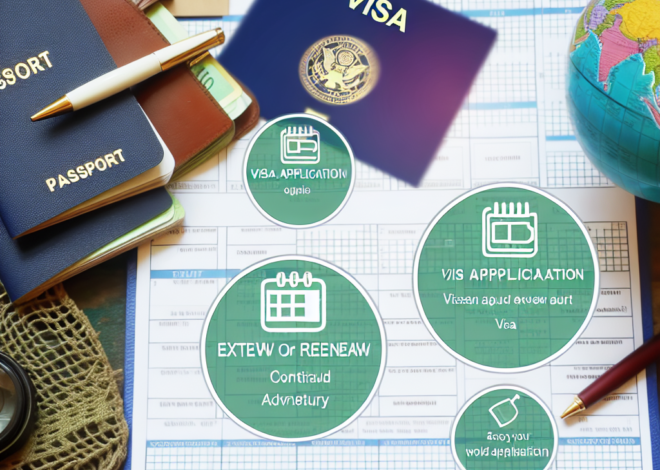
Step-by-step guide to apply for a US student visa
-
Table of Contents
“Unlock Your Future: Your Step-by-Step Guide to Applying for a US Student Visa”
Introduction
Applying for a US student visa is a critical step for international students aiming to study in the United States. This process involves several stages, from securing admission to a U.S. institution to attending a visa interview. A clear understanding of the procedure can help streamline the application process, ensuring that all requirements are met efficiently. This guide provides a comprehensive overview of each step involved in applying for a US student visa, including gathering necessary documents, completing the required forms, and preparing for the visa interview.
Understanding the US Student Visa Application Process: A Step-by-Step Guide
Applying for a US student visa can seem daunting, but understanding the process step-by-step can make it more manageable. This guide provides a comprehensive overview of how to successfully apply for a US student visa, ensuring you meet all the necessary criteria and submit your application correctly.
The first step in applying for a US student visa is to secure admission to an accredited educational institution in the United States. Once you have received your acceptance letter, the institution will enroll you in the Student and Exchange Visitor Information System (SEVIS) and provide you with a Form I-20. This document is crucial as it confirms your eligibility for an F-1 or M-1 visa, depending on whether your course of study is academic or vocational.
After receiving the Form I-20, your next task is to pay the SEVIS I-901 fee. This fee is mandatory for all foreign students and must be paid before you can schedule your visa interview. Payment can be made online, and it’s important to keep a receipt of this transaction, as you will need to present it during your visa interview.
With the SEVIS fee paid, you can now complete the Online Nonimmigrant Visa Application, or Form DS-160. This form collects detailed information about your background, including your education, work history, and the purpose of your visit to the US. Accuracy is paramount when filling out this form, as any errors can delay the processing of your application. After submitting the DS-160, be sure to print the confirmation page, as you will need to bring this to your visa interview.
The next step involves scheduling your visa interview at the US Embassy or Consulate in your home country. Wait times for an interview can vary, so it is advisable to book as early as possible. Prior to your interview, you will need to pay a non-refundable visa application fee, which is separate from the SEVIS fee. Proof of payment should be brought to the interview along with your passport, Form I-20, DS-160 confirmation page, and any other required documents such as academic transcripts, proof of financial support, and test scores that demonstrate your English proficiency.
During the visa interview, a consular officer will determine whether you are qualified to receive a student visa. You should be prepared to answer questions about your study plans, post-graduation plans, and how you intend to finance your education in the US. It is essential to demonstrate that you have strong ties to your home country and that you intend to return home after your studies are completed.
If your visa is approved, you may need to pay a visa issuance fee, depending on your nationality. The consular officer will inform you if this is required and how to pay it. Following approval, your passport will be taken to process your visa, and it will be returned to you with the visa affixed.
Finally, it is important to note that a US student visa can be issued up to 120 days before your course of study begins. However, you are not allowed to enter the United States on your student visa more than 30 days before the start of your program.
By following these steps carefully and preparing thoroughly for each stage of the application process, you can navigate the complexities of applying for a US student visa with confidence. This structured approach not only helps in organizing your application but also in setting clear expectations for the journey ahead in your academic career.
Required Documents for Your US Student Visa Application
When planning to study in the United States, one of the most crucial steps is applying for a student visa. This process involves gathering a comprehensive set of documents to support your application. Understanding and compiling these documents meticulously is essential to ensure a smooth application process.
Firstly, the most fundamental document required is a valid passport. Your passport must be valid for at least six months beyond your period of stay in the United States. This is a standard requirement for most international travel to ensure that your identification remains valid throughout your stay.
Next, you will need to provide proof of your educational qualifications. This includes transcripts, diplomas, degrees, or certificates from schools you attended previously. These documents serve as evidence of your academic achievements and are crucial for the visa officers to assess your eligibility and academic intent.
Another critical document is the Form I-20, which is issued by the U.S. educational institution that you plan to attend. This form is officially titled the “Certificate of Eligibility for Nonimmigrant Student Status.” It confirms that you have been admitted to a program of study and have shown sufficient financial proof to cover your tuition and living expenses while in the United States. You must present the original Form I-20 at your visa interview.
Financial evidence plays a pivotal role in the visa application process. You must demonstrate that you have sufficient funds to cover your tuition and living expenses for the duration of your stay in the U.S. This can be shown through bank statements, financial guarantee letters from sponsors, or scholarship awards. The consular officer needs to be convinced that you can support yourself financially during your studies and that you are unlikely to seek unauthorized employment.
In addition to these documents, you will also need to provide a copy of your admission letter, which shows that you have been accepted by a U.S. institution. This letter should outline the course of study and the duration of the program, reinforcing the details in your I-20 form.
A crucial component of your application is the DS-160 form, which is the Online Nonimmigrant Visa Application form. This form must be completed online and submitted electronically prior to your visa interview. The DS-160 form requires detailed information about your background, including questions about your education, work history, and purpose of travel. After submitting the form, you must print and bring the confirmation page to your interview as it contains your application ID and other vital details.
Lastly, you will need to schedule and attend a visa interview at the U.S. embassy or consulate in your home country. For the interview, ensure you bring all the aforementioned documents, along with any additional documents that might support your application, such as standardized test scores (TOEFL, GRE, GMAT, etc.) that are relevant to your admission.
In conclusion, gathering the correct documentation is a critical step in applying for a U.S. student visa. Each document serves a specific purpose and collectively, they provide a comprehensive profile of your academic, financial, and personal background. By preparing these documents thoroughly and presenting them orderly, you enhance your chances of a successful visa application, paving the way for your educational journey in the United States.
Preparing for Your US Student Visa Interview: Tips and Strategies
Preparing for your US student visa interview is a crucial step in your journey to studying in the United States. This process can be daunting, but with the right preparation and understanding of what is expected, you can approach the interview with confidence. The key to success lies in thorough preparation and a clear understanding of the interview process.
Firstly, it is essential to gather all the necessary documents required for the interview. This includes your passport, admission letter from the U.S. institution, proof of financial support, and the I-20 form issued by the college or university. Ensuring that these documents are complete and well-organized will demonstrate your seriousness and preparedness, which are qualities that consular officers appreciate.
Once you have all your documents in order, the next step is to practice your responses to potential questions that the consular officer might ask. Common questions often revolve around your study plans, your choice of the U.S. as a study destination, your academic capability, and your financial status. Be prepared to explain why you chose a particular school and field of study, and how studying in the U.S. aligns with your career goals. It is crucial to be clear and concise in your answers, showing a direct connection between your studies in the U.S. and your future plans.
Moreover, demonstrating ties to your home country can be an important part of the interview. The consular officer will want to ensure that you have strong reasons to return home after your studies. This could include family ties, property, or a job offer. Be ready to discuss these ties, as failing to convince the officer of your intent to return can lead to visa denial.
Another significant aspect is to practice good communication skills. The interview is conducted in English, and being able to express yourself clearly and effectively is crucial. If English is not your first language, practicing spoken English can help you feel more confident. Remember, it is not just about answering the questions correctly but also about demonstrating your readiness to adapt to and succeed in an English-speaking environment.
Additionally, it is important to be aware of the typical duration and format of the interview. Student visa interviews are usually brief, lasting only a few minutes. Therefore, making a good impression quickly is vital. Dress formally and arrive early for your appointment to avoid any last-minute rush and to show respect for the process.
Lastly, maintaining a positive attitude is essential. Visa interviews can be stressful, but approaching them with a calm and optimistic mindset can help you manage anxiety and perform better. Remember, the interview is not only about assessing your eligibility but also about understanding your motivations and aspirations.
In conclusion, preparing for a US student visa interview requires careful planning and practice. By organizing your documents, practicing your responses, demonstrating ties to your home country, honing your English communication skills, understanding the interview format, and maintaining a positive demeanor, you can enhance your chances of success. Each of these steps plays a crucial role in the overall preparation process, helping you present yourself as a credible and deserving candidate for the student visa.
After the Visa Approval: Next Steps to Take Before Traveling to the US
After receiving approval for your US student visa, a significant milestone has been achieved, but there are several crucial steps you must undertake before you embark on your educational journey to the United States. Ensuring that you are thoroughly prepared for this transition will not only alleviate stress but also set the stage for a successful academic experience.
First and foremost, it is essential to finalize your travel arrangements. Booking your flight well in advance can help you secure the best rates and preferred travel dates. When selecting your flight, consider arriving in the U.S. a few weeks before your program begins. This early arrival will allow you ample time to acclimate to the new environment, adjust to the time zone, and settle into your accommodation without undue haste.
Speaking of accommodation, it is imperative to confirm your living arrangements before departing from your home country. Whether you plan to live on-campus in a dormitory or off-campus in an apartment, ensure that all agreements are signed and deposits are paid. If possible, connect with your future roommates or contact the housing office to inquire about what items are provided and what you might need to purchase upon arrival.
Additionally, it is advisable to familiarize yourself with the local area around your campus. Understanding where you can find essential services such as supermarkets, medical facilities, banks, and public transportation options can significantly ease your initial adjustment period. Many universities offer virtual tours and neighborhood guides, which can be a valuable resource.
Another critical step is to set up your health insurance. Most educational institutions require international students to have health insurance during their stay in the U.S. Often, universities provide their own health plans, but you also have the option to arrange for private insurance. Make sure to compare different plans and choose one that best suits your needs, ensuring it complies with both your university’s requirements and visa regulations.
Furthermore, it is crucial to register for an orientation program at your university. These programs are designed to help new students understand academic policies, register for classes, and meet other students. They also provide a wealth of information about campus resources, such as libraries, counseling services, and career centers. Participating in orientation is not only beneficial for smoothing your academic transition but also offers a great opportunity to start building your social network.
Before you leave, make sure to organize your financial matters. This includes setting up a bank account in the U.S., understanding the currency exchange rate, and arranging for sufficient funds to cover initial expenses before you set up a more permanent financial solution. Some banks offer special accounts for international students, which can be set up from your home country.
Lastly, ensure that all your important documents are in order, including your passport, visa, acceptance letter, scholarship letters if applicable, and medical records. It is wise to make several photocopies of these documents and keep them in different places in case of loss or theft.
By methodically addressing each of these areas, you can ensure that your transition to studying in the U.S. is as smooth and stress-free as possible. Remember, preparation is key to overcoming the challenges of adjusting to a new academic system and culture.



